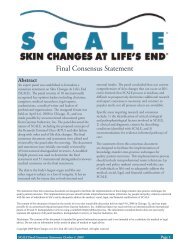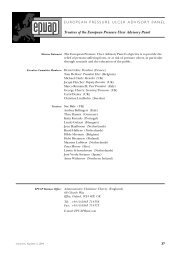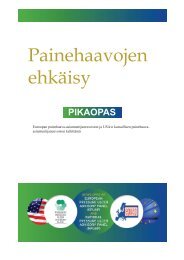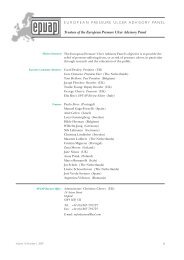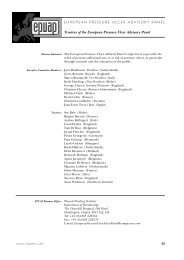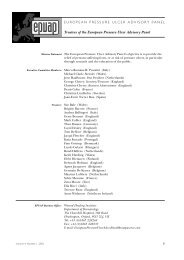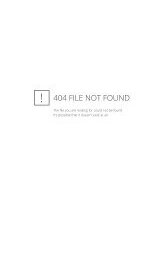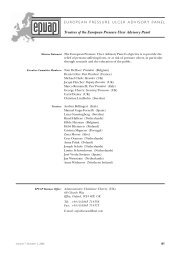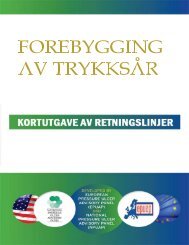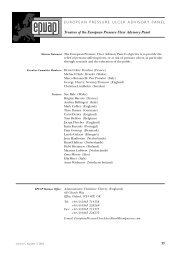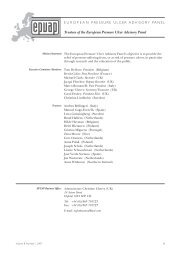EPUAP Review 5/2 RIP - European Pressure Ulcer Advisory Panel
EPUAP Review 5/2 RIP - European Pressure Ulcer Advisory Panel
EPUAP Review 5/2 RIP - European Pressure Ulcer Advisory Panel
Create successful ePaper yourself
Turn your PDF publications into a flip-book with our unique Google optimized e-Paper software.
50<br />
epuap Report<br />
EUROPEAN PRESSURE ULCER ADVISORY PANEL<br />
from the Guideline Development Group<br />
<strong>EPUAP</strong> GUIDELINES<br />
On the Role of Nutrition in <strong>Pressure</strong> <strong>Ulcer</strong> Prevention and Management<br />
THIS issue of the <strong>EPUAP</strong> <strong>Review</strong> reproduces the draft<br />
text of a new <strong>EPUAP</strong> guideline covering the role of<br />
nutrition in pressure ulcer prevention and management.<br />
This guideline was initiated by the late Professor Gerry<br />
Bennett during the <strong>EPUAP</strong> Open Meeting held in Budapest<br />
last year. Since September 2002, the guideline development<br />
group (members listed below) met in Amsterdam<br />
in February 2003 with subsequent revisions to the draft text<br />
made via e-mail. This draft guideline will be presented for<br />
discussion during the <strong>EPUAP</strong> Open Meeting to be held in<br />
Tampere. All comments received during this presentation<br />
will be considered by the guideline development group and<br />
the text revised where appropriate. If you have any comments<br />
regarding the content of this draft guideline please<br />
send them to the <strong>EPUAP</strong> Business Office by the end of<br />
October 2003. We have also reproduced the list of references<br />
on pressure ulcers and nutrition considered by the<br />
guideline development group.<br />
Membership of the Guideline Development Group<br />
Professor Gerry Bennett (UK)<br />
Dr Michael Clark (Facilitator, UK)<br />
Dr Joseph Schols (Netherlands)<br />
Dr Giuseppe Benati (Italy)<br />
Mr Gero Langer (Germany)<br />
Mrs Pam Jackson (UK)<br />
Mrs Bernadette Kerry (Ireland)<br />
Draft for Discussion – Version 4<br />
<strong>European</strong> <strong>Pressure</strong> <strong>Ulcer</strong> <strong>Advisory</strong> <strong>Panel</strong><br />
Guideline on nutrition in pressure ulcer<br />
prevention and treatment.<br />
Clinical Need for this Guideline<br />
<strong>Pressure</strong> ulcers are the result of a complex interplay between<br />
myriad extrinsic and intrinsic risk factors – excessive<br />
mechanical loading, immobility, incontinence, advanced<br />
age among many others. While the consequences of immobility<br />
are often viewed as the key predisposing factors in<br />
prompting the development of a pressure ulcer, it is often<br />
assumed that there is also a direct causal relationship between<br />
nutrition and pressure ulcer development. The scientific<br />
basis for this assumption is unclear with as yet no<br />
sound studies linking impaired nutrition and an increased<br />
incidence of pressure ulcers. However, it is possible that<br />
impaired nutrition may influence tissue vulnerability to<br />
extrinsic factors such as pressure. It is important to note<br />
that only a few risk factors can be influenced by our actions<br />
– tissue loading and nutrition being two key issues we can<br />
address. The perceived importance of malnutrition in pressure<br />
ulcer development and management is briefly considered<br />
within existing <strong>EPUAP</strong> guidelines; for example:<br />
• a full risk assessment in patients to include: General<br />
skin condition, skin assessment, mobility, moistness<br />
and incontinence, nutrition and pain,<br />
• following assessment nutritionally compromised<br />
individuals should have a plan of appropriate support<br />
and/or supplementation that meets individual needs<br />
and is consistent with overall goals of therapy,<br />
• ensure adequate dietary intake to prevent malnutrition<br />
to the extent that this is compatible with the<br />
individual’s wishes or condition.<br />
The purpose of this guideline is to expand upon the<br />
references to malnutrition within existing <strong>EPUAP</strong> guidelines<br />
and provide clinicians with specific guidance upon<br />
nutritional screening and assessment and following assessment,<br />
appropriate intervention. It is intended that the<br />
guidelines be appropriate for all care settings although it is<br />
recognized that the access to specific tools such as weighing<br />
scales and personnel such as dieticians may be limited<br />
in some sectors.<br />
The recommendations offered in this guideline have<br />
been graded using the following systems:<br />
Volume 5, Number 2, 2003



